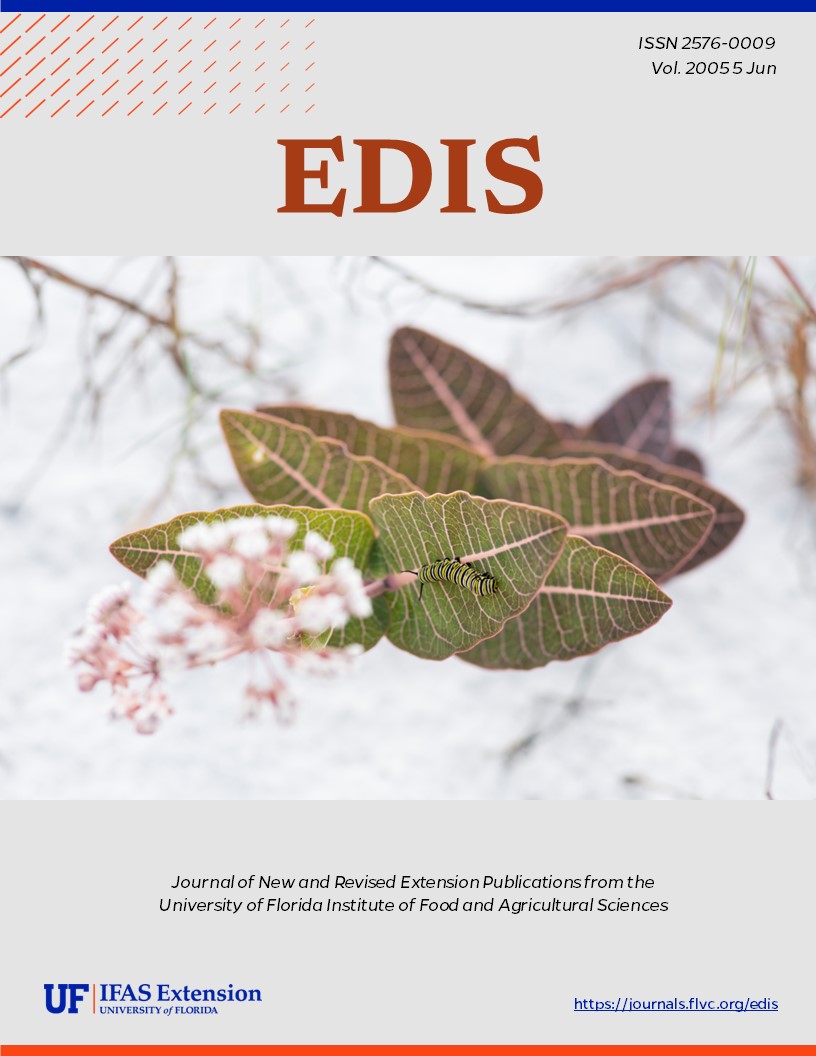Abstract
The family Phengodidae are uncommonly encountered beetles that have bioluminescent females that appear to be larvaiform (or larger versions of the immature stage.) These adult females are able to produce light from paired photic organs located on each body segment (one glowing spot on each side) and sometimes also from luminous bands that extend across the dorsal surface of the body between each body segment. Females appear to be more commonly encountered than larvae. Because these glowing spots along the females body resemble the windows of train cars internally illuminated in the night, they are often referred to as "railroad-worms." Males of these species are not larviform, but instead resemble other beetles, though their first pair of wings (elytra) are less then half as long as their hind wings and the males of most species have very elaborate, feather-like antennae. These fancy antennae are used to detect and follow pheromones produced by the female. This document is EENY-332 , one of a series of Featured Creatures from the Entomology and Nematology Department, Florida Cooperative Extension Service, Institute of Food and Agricultural Sciences, University of Florida. Published: December 2004. Revised: February 2005.
EENY332/IN609: Glow-Worms, Railroad-Worms (Insecta: Coleoptera: Phengodidae) (ufl.edu)
References
Barber HS. 1906. Note on Phengodes in the vicinity of Washington, D.C. Proceedings of the Washington Entomological Society 7:196-197.
Branham MA, Wenzel JW. 2001. The evolution of bioluminescence in cantharoids (Coleoptera: Elateroidea). Florida Entomologist 4:565-586. https://doi.org/10.2307/3496389
Costa C, Vanin SA, Casari SA, Viviani VR. 1999. Larvae of neotropical Coleoptera. XXVII Phrixothrix hirtus: immature, neotenic female, adult male and bionomic data (Phengodinae, Phengodidae, Coleoptera). Iheringia Serie Zoologia, Porto Alegre 86:9-28.
Lawrence JF, Hastings AM, Dallwitz MJ, Paine TA, Zurcher EJ. (1999). Beetles of the World: A Key and Identification System for Families and Subfamilies. (CD-ROM Version 1.0 for Windows). CSIRO Publishing, Melbourne.
LeSage L. 1991. Phengodidae (Cantharidea) (including Rhagophthalmidae). p. 424-426 In Stehr F. (ed.) Immature Insects. Kendall/Hunt Publishing Company, Dubuque, Iowa. 975pp.
Miller R. 1997. Female Phengodes feeding and an associated risk (Coleoptera: Phengodidae). Entomological News 108:213-214.
O'Keefe S. 2002. Phengodidae LeConte 1861, p. 181-186 In Arnett Jr. R, Thomas MC, Skelly PE, Frank JH. (eds.) American Beetles. Vol. 2. CRC Press, New York, NY. 861pp.
Tiemann D. 1967. Observation on the natural history of the western banded glow-worm Zarhipis integripennis. Proceedings of the California Academy of Sciences 35:235-264.
Tiemann D. 1970. Nature's toy train, the railroad worm. National Geographic 138:58-67.
Viviani VR, Bechara JH. 1997. Bioluminescence and biological aspects of Brazilian railroad- worms (Coleoptera: Phengodidae). Annals of the Entomological Society of America 90:389-398. https://doi.org/10.1093/aesa/90.3.389
Wing S. 1984. A spate of glow-worms (Coleoptera: Phengodidae). Entomological News 95:55- 57.
Wittmer W. 1975. The genus Phengodes in the United States (Coleoptera: Phengodidae). Coleopterists Bulletin 29:231-250.
Wittmer W. 1981. Zur kenntnis der Familie Phengodidae (Coleoptera). Mitteilungen der Entomologischen Gesellschaft Basel Neve Folge 31:105-107.
Zaragoza CS. 1984. Catalogo de la familia Phengodidae. Anales del Instituto de Biologia Universidad Nacional Autonoma de Mexico 55:307-324.

